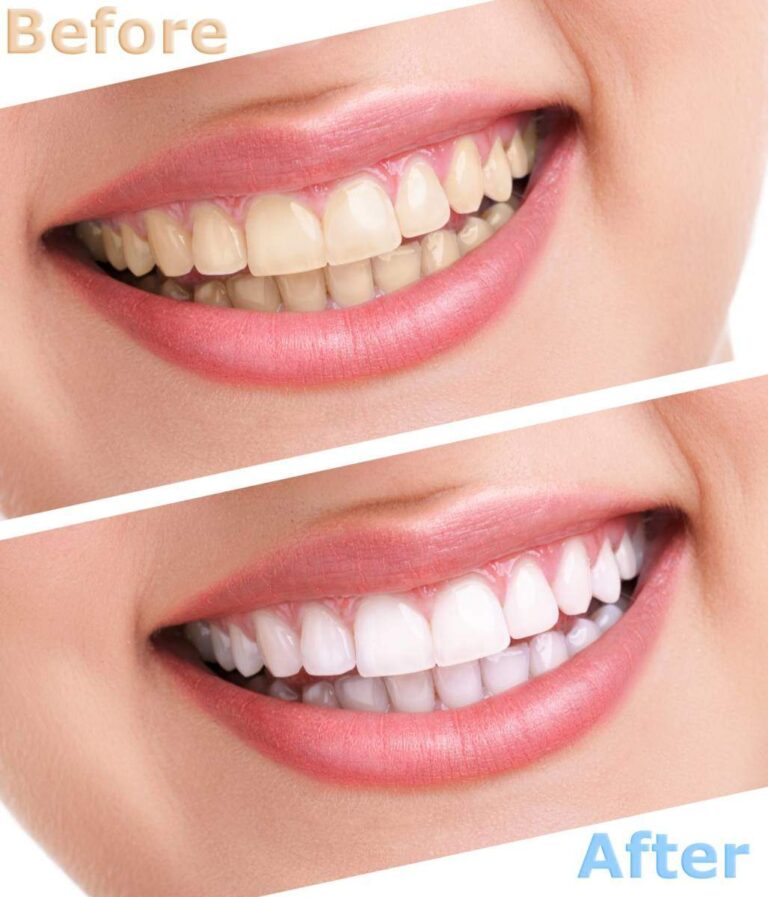Teeth whitening is the most popular cosmetic dentistry procedures around. Why? Well, because it’s a simple process, most dentists offer it and it’s one of the most cost effective ways to brighten your smile.
Causes of Teeth Discoloration
As we get older, the color of our teeth usually darkens and can appear yellow or stained. There are a number of reasons this happens. Common issues that affect the surface of your teeth and can cause darkening or discoloration include:
Age: Yep, just getting older can make your teeth darker. As you age, the outer enamel layer of your teeth gets thinner which lets more of the yellowish dentin layer underneath show through.
Drinking dark beverages: Coffee, tea and red wine are common beverages many people enjoy that lead to staining of your teeth.
Food: Certain types of food can lead to surface discoloration as well. Foods that can do this include: dark veggies such as beets or carrots, fruits with a lot of pigment like berries, colorful spices like curry or turmeric as well as brightly colored candies.
Tobacco: The tar and nicotine in cigarettes pack a nasty one-two punch on your teeth. Tar is a naturally dark substance that leads to staining. Nicotine, when it mixes with oxygen, turns into a yellowish substance that can stain your teeth.
Intrinsic Stains
Intrinsic stains, which happen when discoloration occurs deeper in your teeth’s structure, are less talked about but are worth knowing about. Common causes of intrinsic stains include:
Trauma: A trauma to the mouth can lead to a darker color as the mouth reacts to the injury by producing more dentin (the darker layer under the enamel).
Fluoride: Fluoride is great for fighting cavities but kids that get too much fluoride are at risk of discoloration.
Medication: Young kids that get too much antibiotics like tetracycline when their teeth are developing can get discoloration of their adult teeth later in life. Also, discoloration can be a side effect of some high blood pressure drugs, antihistamines and anti-psychotic medications.
Teeth Whitening Options
If your teeth are discolored and you’re looking for a whiter, brighter, younger looking smile, there are a number of options. These options fall into 2 broad categories: In-Office Teeth Whitening and Do-It-Yourself (DIY) or Home Teeth Whitening.
In-Office Teeth Whitening
Most dentists offer some sort of in-office teeth whitening procedure. The cost of this whitening procedure varies depending on the specific procedure you choose and where in the country you live. You can figure on the cost averaging around $500.
Professional teeth whitening involves applying a strong bleaching agent to the teeth. The bleach is much stronger than what you will find in a DIY product. Also, when you have an experienced professional do your teeth whitening they can protect the rest of your mouth (gums, enamel, etc.) from the bleaching material. They are also well qualified to handle any unexpected issues that may come up such as tooth sensitivity.
In-office teeth whitening typically takes between 1-3 hours and is accomplished in a single visit. The effects can last for a year or more depending on how well you take care of your teeth.
DIY or Home Teeth Whitening
There are plenty of home teeth whitening options including toothpastes, whitening strips, whitening gum, paint on gels and mouth trays with gel.
The agents used in home teeth whitening products are much weaker than those used at a dentist’s office. Due to the weaker agent, it may take longer to get the results you desire.






